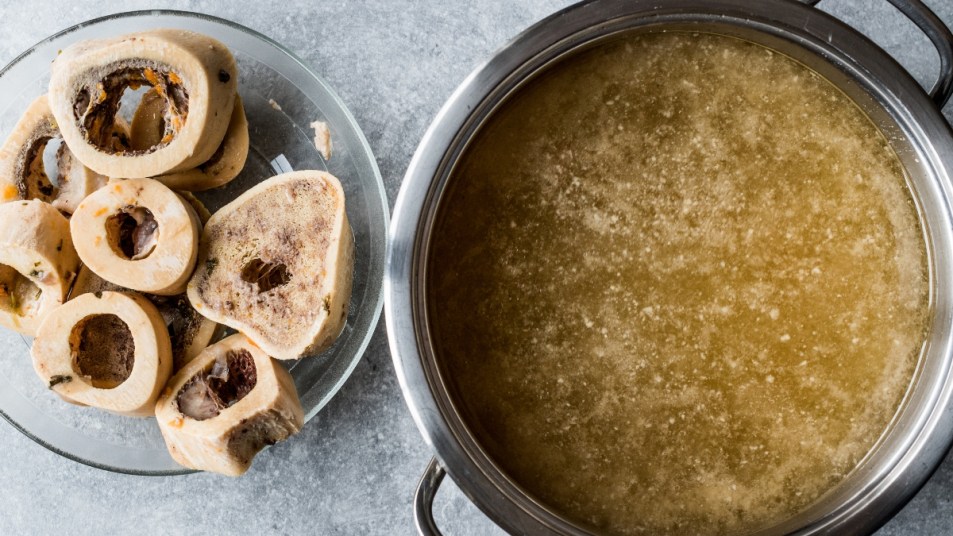The Many Mighty Benefits of Bone Broth: From Better Sleep to Firmer Skin
It's relatively simple to make at home.

Bone broth is currently all the buzz in the health and wellness scene. Folks rave about how much firmer their skin is after eating bone broth for awhile and how much better their joints feel. Others report sleeping better after they took up bone broth. Intrigued, we decided to take a look at the science behind then sensation.
What is bone broth?
Bone broth (or bone stock) is a savory liquid made by simmering animal bones and connective tissues in water for six to 24 hours. Its flavor and health benefits are the result of this slow simmer. Over a period of several hours, the nutrients and proteins in the bones and connective tissue transfer to the water, creating a tasty, nutrient-dense broth. Often seasoned with herbs and veggie scraps, bone broth can be used as a base for soups or consumed on its own.
In traditional Asian cuisine, bone broth often appears as a palette cleanser. In fact, it’s a staple, of diets around the world. In the US, its dense, meaty liquid has made it a popular superfood and a key ingredient in the paleo diet.
What are the health benefits of bone broth?
Unlike fad diets and social media health trends, the benefits of drinking bone broth are supported by science. Here’s how bone broth can positively impact your health.
First, bone broth is rich in important vitamins and minerals, including potassium, magnesium, phosphorus, calcium, and potassium, that support our own bone and connective tissue health. The most nutrient-rich part of a bone, the bone marrow, contributes zinc, manganese, iron, selenium, and vitamins A and K2, all of which are important for promoting overall wellness and a strong immune system. Bone marrow also contains omega fatty acids like omega-3 and omega-6, which are critical for supporting brain health. And the longer the broth simmers, the more nutrients leach out of the bones and tissue — thus, the more health benefits for you.
Bone broth provides collagen to firm skin
Bones and connective tissue are filled with collagen, a key protein used to make our skin, tendons, cartilage, and muscles strong. This can help prevent osteoarthritis and other bone diseases, as well as improve skin elasticity. Unfortunately, though collagen is one of the most abundant proteins in the human body, we produce less and less of it as we age. This is why a collagen-rich diet is especially important later in life. Other behaviors, such as smoking and not getting enough sleep, can also reduce collagen production. Research on the efficacy of collagen in supplement form is mixed, but the science showing bone broth is a great source of this nutrient is rock-solid. So, rather than adding collagen powder or capsules to your daily supplements, consider incorporating bone broth into your next meal instead.
Related: Collagen for Women: Adding a Little To Your Smoothie May Make Skin Look Years Younger
Bone broth can help ease digestive issues
How many of us struggle with bloating, gas, and other digestive issues? Too many to count. The good news is that the fix might be found in the aisles of your neighborhood supermarket! Bone broth is full of gelatin, which binds to water and helps food move through your digestive tract more easily. Gelatin also contains an important amino acid called glutamine, which helps prevent leaky gut syndrome (a gut health condition in which the barrier between your intestinal wall and bloodstream is damaged or impaired). Though it may look like a simple liquid that replenishes your electrolytes and provides some hydration, bone broth is actually bursting with nutrients.
Bone broth helps to support weight loss
Despite how tasty and filling bone broth is, both chicken bone broth and beef bone broth are surprisingly low calorie, making them great options for those trying to lose weight healthfully. Numerous studies support eating chicken soup (and other similar soups) for satiety; basically, feeling fuller longer with low calorie consumption and high nutrient intake. Additional research shows that people who consume soup as a regular part of their diet are less likely to gain weight or experience obesity. In other words, adding bone broth to your routine will assuage your hunger without sacrificing your diet.
Of course, this makes intuitive sense. There’s something about a comforting bowl of warm soup; It satisfies the appetite in ways that other healthy foods can’t. Replace your regular soup broth with bone broth, and you not only have a delicious and filling low-calorie meal — you’re also nourishing your mind and body with essential vitamins, minerals, and proteins.
Related: Dr. Axe’s Bone Broth Fast: Lose Up to 21 Pounds in 10 Days Without Feeling Hungry
Bone broth can improve sleep quality
Another protein building block found in bone broth is amino acid glycine, which is critical for regulating sleep habits and maintaining brain health. During the day, glycine can help reduce sleepiness and regulate memory; at night, it’s been shown to have the opposite effect — encouraging sleep and improving sleep. In general, glycine is a hard worker for your circadian rhythm, helping you stay alert during the day and asleep during the night. All you have to do to reap these benefits is drink some keto-friendly, nutritionist-approved bone broth soup.
Bone broth can help fight inflammation
In addition to promoting healthy sleep habits, glycine — along with another amino acid, arginine — is an anti-inflammatory. These powerful amino acids can help to reduce chronic inflammation, which has correlates with obesity, joint pain, heart disease, and more. Combined with the tissue and ligament-strengthening collagen found in bone broth, glycine and arginine make consuming this hearty liquid one of the simplest changes you can make toward improving your joint health.
Can I make bone broth at home?
The easiest way to incorporate bone broth into your diet is to purchase it pre-made. You can, however, make bone broth at home (where it will likely be healthier, tastier, and cheaper). The first step is to procure the bones. If you regularly buy rotisserie chicken or bone-in fish, you can save those bones by storing them in your freezer until you’re ready to use them. You can also ask your local butcher or the meat department of the grocery store for leftover bones — they may even give them to you for free. If possible, seek bones from grass-fed beef or free-range chickens, as these will typically come from healthier animals, which means a healthier bone broth.
The first step in the cooking process is to place the bones in a slow cooker or large pot along with water, apple cider vinegar, and seasoning (usually salt and pepper). According to Healthline, a good starter recipe for your own bone broth includes:
- 2 to 4 pounds animal bones
- 1 gallon water
- 2 tbsp apple cider vinegar
- Seasoning to taste
Apple cider vinegar helps break down the bones and tough tissues, so don’t forget to include it. The simplest bone broth recipes will call only for salt and pepper, but don’t be afraid to add thyme, parsley, garlic, celery, or other herbs and spices. Once the mixture is boiling, reduce the heat and let it simmer for six to 24 hours (although we recommend at least 12 hours). The longer it cooks, the more flavor and nutrients the bones release.
Bone Broth Storage… and Final Thoughts
Bone broth is easy to make in large batches, but it only stays good in the fridge for around five days. If you think you’ll go through your batch much slower than that, freeze it and keep it in the freezer to be reheated when needed. There truly isn’t a more low-cost, low-calorie, nutrient-dense food out there.
Whether you’re trying to lose weight, improve your digestive health, support healthy bones and joints, get better sleep, or just find a tasty alternative to your go-to soup recipe, a hearty serving of bone broth just might be the solution you seek. So, start that simmer, and enjoy all the benefits bone broth has to offer.













